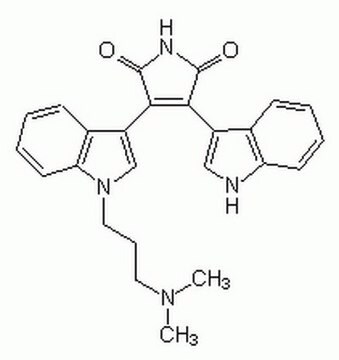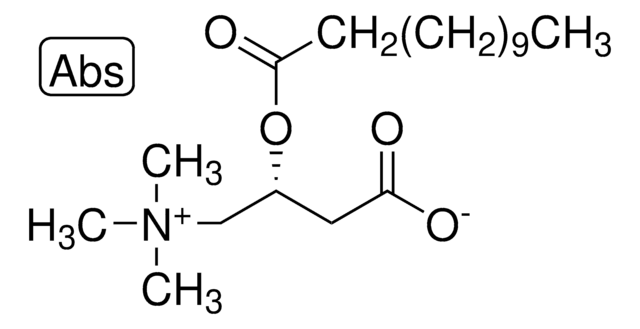A269
Anti-A2A Adenosine Receptor antibody produced in rabbit
affinity isolated antibody, buffered aqueous solution
Sign Into View Organizational & Contract Pricing
All Photos(1)
About This Item
Recommended Products
biological source
rabbit
Quality Level
conjugate
unconjugated
antibody form
affinity isolated antibody
antibody product type
primary antibodies
clone
polyclonal
form
buffered aqueous solution
mol wt
antigen ~45 kDa
species reactivity
canine, human
should not react with
rat
technique(s)
immunohistochemistry (frozen sections): 1:100
immunoprecipitation (IP): suitable
western blot: 1:2000
UniProt accession no.
shipped in
dry ice
storage temp.
−20°C
target post-translational modification
unmodified
Gene Information
human ... ADORA2A(135)
General description
ADORA2A is an adenosine receptor and part of the G-protein coupled receptor family of proteins. ADORA2A is involved in regulating myocardial blood flow and dopamine release in the brain.
Anti-A2A Adenosine Receptor is specific for A2A adenosine receptor adenosine receptor subtype. By immunoblotting, it reacts strongly with canine A2A. However, it does not react with rat A2A. The antibody detects A2A adenosine receptor in human hippocampus by immunohistology and may be used for immunoprecipitation.
Immunogen
Synthetic peptide (Ser-His-Gly-Asp-Met-Gly-Leu-Pro-Asp-Val-Glu-Leu-Leu-Ser-His-Glu-Leu-Lys) derived from amino acids 373-391 of the canine A2A adenosine receptor C-terminal domain.
Application
Rabbit anti-A2A adenosine receptor antibody can be used for western blot applications. The antibody can also be used for immunohistochemistry (1:100, frozen sections) and immunoprecipitation applications.
Physical form
Solution in phosphate buffered saline, containing 1 mg/ml BSA and 0.05% sodium azide.
Disclaimer
Unless otherwise stated in our catalog or other company documentation accompanying the product(s), our products are intended for research use only and are not to be used for any other purpose, which includes but is not limited to, unauthorized commercial uses, in vitro diagnostic uses, ex vivo or in vivo therapeutic uses or any type of consumption or application to humans or animals.
Not finding the right product?
Try our Product Selector Tool.
Storage Class Code
10 - Combustible liquids
WGK
WGK 1
Flash Point(F)
Not applicable
Flash Point(C)
Not applicable
Personal Protective Equipment
dust mask type N95 (US), Eyeshields, Gloves
Choose from one of the most recent versions:
Already Own This Product?
Find documentation for the products that you have recently purchased in the Document Library.
T M Palmer et al.
Molecular pharmacology, 45(6), 1082-1094 (1994-06-01)
Stable cell lines that express the canine-derived A2a adenosine receptor (A2aAR) have been generated. Using a previously characterized anti-A2aAR antibody probe, we have identified the recombinant receptor protein and examined the desensitization process of this G protein-coupled receptor. Agonist exposure
Liping Gao et al.
The Journal of pharmacology and experimental therapeutics, 305(2), 581-586 (2003-02-28)
Hypertension in spontaneously hypertensive rats (SHRs) is due in part to enhanced effects of vasoactive peptides on the renal vasculature. We hypothesize that the G(i) signal transduction pathway enhances renovascular responses to vasoactive peptides in SHRs more so than in
R B Marala et al.
The Journal of pharmacology and experimental therapeutics, 286(2), 1051-1057 (1998-08-08)
Antipeptide antibody was raised in rabbit against the sequence (361-390) of RDC-8, the presumed adenosine A2A receptor cDNA from canine. The antibody titer was estimated by solid phase radioimmunoassay. Western blot analysis under reducing conditions identified a major 45 +/-
Zhiping Liu et al.
Nature communications, 8(1), 584-584 (2017-09-21)
Adenosine/adenosine receptor-mediated signaling has been implicated in the development of various ischemic diseases, including ischemic retinopathies. Here, we show that the adenosine A2a receptor (ADORA2A) promotes hypoxia-inducible transcription factor-1 (HIF-1)-dependent endothelial cell glycolysis, which is crucial for pathological angiogenesis in
Krista M Beach et al.
Experimental eye research, 174, 40-50 (2018-05-25)
Adenosine receptor (ADOR) antagonists, such as 7-methylxanthine (7-MX), have been shown to slow myopia progression in humans and animal models. Adenosine receptors are found throughout the body, and regulate the release of neurotransmitters such as dopamine and glutamate. However, the
Our team of scientists has experience in all areas of research including Life Science, Material Science, Chemical Synthesis, Chromatography, Analytical and many others.
Contact Technical Service








